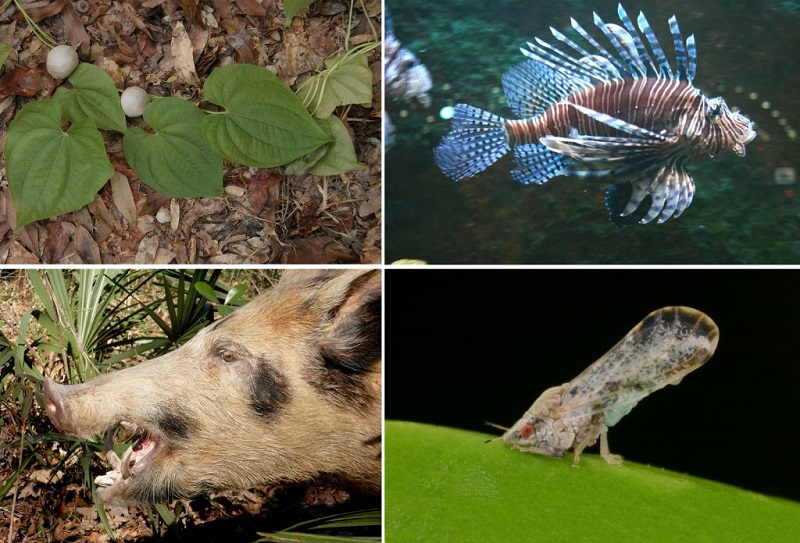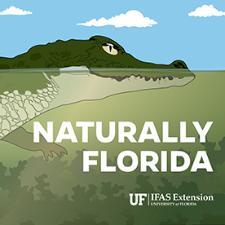February 28 – March 4 is National Invasive Species Awareness Week, and UF/IFAS Extension agents throughout Florida have been raising awareness about invasive species and how we can limit their impact on our state’s economy, our natural ecosystems and our everyday lives.
In January, during a cold snap, I learned about the falling iguanas. Iguanas are adapted to the consistently warm temperatures of their native habitats in Central America. However, they are now found as an invasive species in Florida. The unexpected cold temperatures of their new home can stun the reptiles, and they’ve been known to fall out of their perches in trees. Social media and news outlets were full of meteorological alerts about iguana falls. I thought—Only in Florida!
But falling out of the sky is just one threat imposed by invasive iguanas. Green iguanas in South Florida have disrupted native ecosystems and may be responsible for losses of the endangered Miami blue butterfly in the Florida Keys. They also damage sea walls and other structures with their burrows. West Palm Beach recently spent almost $2 million to repair a dam weakened by nesting iguanas.
Any organism that enters Florida from somewhere else and becomes a problem because it harms native plants or animals, human health, or the economy, is considered an invasive species. Such invasive species are a huge problem in our state. Florida is consistently second only to Hawaii in the damage invasive species cause to agriculture and natural ecosystems. News stories frequently feature the hydrilla that clog our waterways, Burmese pythons that wreak havoc in the Everglades, lygodium that create fire hazards in our forests, and psyllids that spread citrus greening disease across our orange groves. And for every one of these high-profile invaders, there are hundreds of lesser-known organisms that damage crops, spread disease, displace native species and upset balanced ecosystems.
Invasive plants, animals and diseases cause an estimated $179 million in agricultural losses in Florida each year. Source: AskIFAS

Because the impacts of invasive species affect every aspect of our lives in all parts of Florida, UF/IFAS Extension addresses this issue across all our program areas, bringing science to help Floridians recognize invasive species, understand their threat and take safe and effective steps to lessen their impact.
The UF/IFAS Invasive Species Council is a growing statewide network of UF/IFAS Extension specialists and agents who are working together to address problems caused by invasive organisms of all types more strategically and more effectively. Their website is a great place to start learning: https://invasivespecies.ifas.ufl.edu/
I recently sat down with Dr. Stephen Enloe with the Center for Aquatic and Invasive Plants, and Dr. Lynn Gettys of the Ft. Lauderdale Research and Education Center to discuss the broad efforts Extension is bringing to this complex issue. You can view the discussion as part of our Extension Connections webinar series: https://go.ufl.edu/a2q8808.
 The issue of invasive species can be complex; even the terminology can be confusing. What’s the difference between a native and a non-native? Can a native species be invasive? What about “exotic” species? To help sort out these terms, give a listen to “Naturally Florida”, a podcast series presented by natural resource Extension agents Shannon Carnevale and Lara Milligan. In their latest episode, “Words Matter: When and How to Use the Words Invasive Species”, the two hosts have a fun and engaging conversation that will settle bets and clear up any confusion. They also provide a list of helpful resources in their program notes. You can find a link to the podcast here: https://sfyl.ifas.ufl.edu/polk/natural-resources-and-conservation/Naturally-florida-podcast/
The issue of invasive species can be complex; even the terminology can be confusing. What’s the difference between a native and a non-native? Can a native species be invasive? What about “exotic” species? To help sort out these terms, give a listen to “Naturally Florida”, a podcast series presented by natural resource Extension agents Shannon Carnevale and Lara Milligan. In their latest episode, “Words Matter: When and How to Use the Words Invasive Species”, the two hosts have a fun and engaging conversation that will settle bets and clear up any confusion. They also provide a list of helpful resources in their program notes. You can find a link to the podcast here: https://sfyl.ifas.ufl.edu/polk/natural-resources-and-conservation/Naturally-florida-podcast/
 “Working in the Weeds” is another podcast, devoted to the issue of invasive plants. Host Dr. Jay Ferrell of the Center for Aquatic and Invasive Plants is an excellent speaker who breaks down the issue of invasive species in a clear and entertaining way. You can find a link to ”Working in the Weeds” here: https://anchor.fm/ufifascaip.
“Working in the Weeds” is another podcast, devoted to the issue of invasive plants. Host Dr. Jay Ferrell of the Center for Aquatic and Invasive Plants is an excellent speaker who breaks down the issue of invasive species in a clear and entertaining way. You can find a link to ”Working in the Weeds” here: https://anchor.fm/ufifascaip.
There will also be educational events and invasive species roundups going on throughout the state, presented by Extension agents working with local Cooperative Invasive Species Management Areas (CISMA). There will even be an Iguana Rodeo presented by the Suncoast CISMA. Contact your county Extension office to learn about events in your area: https://sfyl.ifas.ufl.edu/
National Invasive Species Awareness Week runs from February 28 through March 4, but the struggle is ever ongoing and UF/IFAS Extension will be there to help contain the damage wrought by invasive species in Florida.
 2
2
